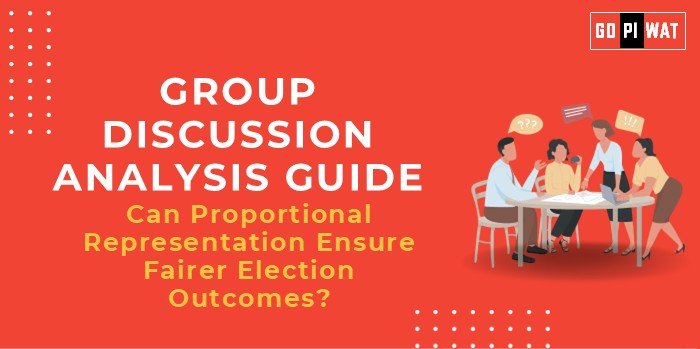📋 Group Discussion (GD) Analysis Guide: Can Proportional Representation Ensure Fairer Election Outcomes?
🌐 Introduction to the Topic
- 📖 Context: Electoral systems directly influence the fairness and inclusivity of democratic representation. Proportional representation (PR), which allocates seats based on vote share, contrasts with majoritarian systems like first-past-the-post (FPTP) that often distort representation.
- 💡 Background: Countries like Germany, New Zealand, and South Africa use PR systems, offering lessons on their ability to deliver equitable outcomes. The topic raises questions about the trade-offs between representation and governance stability.
📊 Quick Facts and Key Statistics
- 🌍 Global Usage: 89 countries, including Germany and Sweden, use proportional representation.
- 📈 Seat-Vote Disparity: In India’s 2019 elections, a party with 37.4% vote share won 55% of parliamentary seats, exemplifying FPTP distortions.
- 🔄 Voter Turnout Impact: PR systems generally report 5–12% higher voter turnout compared to majoritarian systems (IDEA, 2023).
- 👩⚖️ Inclusivity: Women and minorities have higher representation in PR systems, with women’s participation reaching 42% in Nordic countries under PR.
👥 Stakeholders and Their Roles
- 🏛️ Political Parties: Strategize differently under PR to appeal to diverse voter bases.
- 🗳️ Voters: Experience a more accurate translation of votes into representation.
- 💼 Governments: Benefit from or grapple with coalition dynamics.
- 📡 Civil Society: Advocates for electoral reform and studies its effects.
- 🔍 Electoral Commissions: Ensure transparency and fairness in system implementation.
🏆 Achievements and Challenges
✨ Achievements:
- 🤝 Inclusivity: Enhanced representation of smaller parties, minorities, and women.
- ✅ Reduced Wasted Votes: Almost all votes contribute to outcomes, unlike FPTP.
- ⚖️ Coalition Governance: Promotes compromise and moderation in policymaking.
- 🌍 Global Success: PR systems in Germany and New Zealand have led to stable, inclusive governments.
⚠️ Challenges:
- 📉 Fragmentation: PR systems can result in fragmented parliaments, complicating governance.
- 🔄 Coalition Instability: Frequent government collapses in countries like Israel.
- 🛠️ Administrative Complexity: Greater challenges in counting and seat allocation.
- 🌐 Global Comparisons:
- ✅ Success: Germany’s stable coalition governments.
- ⚠️ Challenges: Italy’s frequent political instability.
📄 Structured Arguments for Discussion
- 👍 Supporting Stance: “Proportional representation ensures every vote counts, leading to fairer representation of societal diversity.”
- 👎 Opposing Stance: “PR systems often lead to unstable coalition governments, undermining governance efficiency.”
- ⚖️ Balanced Perspective: “While PR enhances inclusivity, its success depends on political maturity and strong institutional frameworks.”
💬 Effective Discussion Approaches
- 🎯 Opening Approaches:
- 📊 Highlight data: “Countries using PR report 12% higher female representation, proving its inclusivity.”
- 🌍 Compare systems: “Unlike FPTP, PR ensures even small parties and minorities gain representation.”
- 🤝 Counter-Argument Handling:
- ✅ Acknowledge coalition challenges but emphasize better voter satisfaction.
- 💡 Suggest hybrid systems, such as mixed-member proportional representation (e.g., Germany).
🔎 Strategic Analysis of Strengths and Weaknesses
- 💪 Strengths: Reflects voter diversity, reduces wasted votes, fosters cooperation.
- ❌ Weaknesses: Governance complexity, potential instability.
- 🌟 Opportunities: Combines PR with FPTP features for balance.
- ⚠️ Threats: Resistance from dominant political parties in existing majoritarian systems.
🎓 Connecting with B-School Applications
- 🌍 Real-World Applications: Leadership in coalition settings, decision-making under pluralistic constraints.
- 📝 Sample Interview Questions:
- 💡 “How does proportional representation improve democratic fairness?”
- 🔍 “What lessons can be drawn from countries using PR for governance?”
- ✨ Insights for Students: Analyze decision-making frameworks in coalition-led governance.


